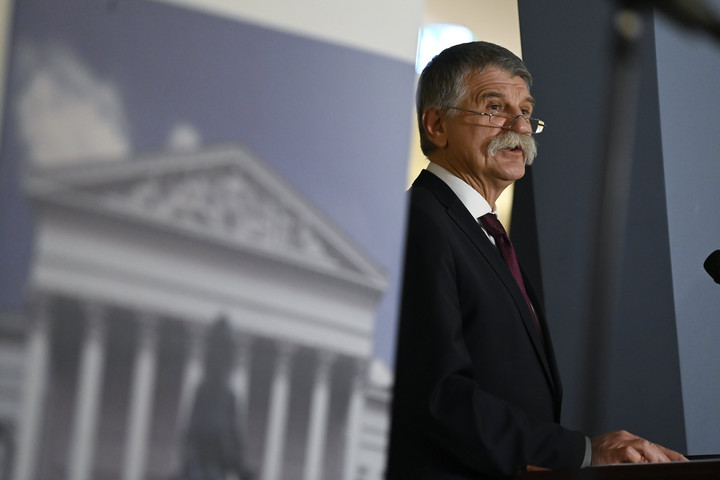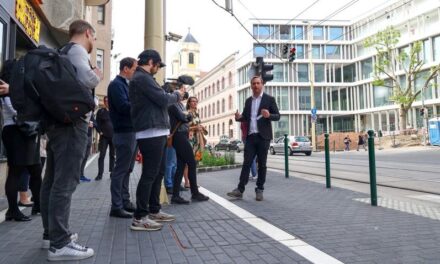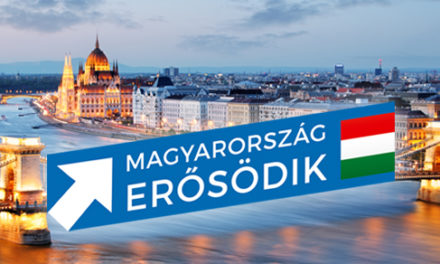The 220-year-old National Museum as a house of Hungarian memory was not only more than a museum when it was founded, but also today. This institution has been one of the strongholds of the spiritual national defense of Hungarians for more than two centuries, and it must remain so, emphasized the President of the Parliament on Thursday, the 220th anniversary of the establishment of the institution.
László Kövér said during the break of the anniversary conference organized at the Hungarian National Museum, before the ceremonial handing over of reliefs commemorating the three former directors of the institution, László Fejérpataky, Bálint Hóman and István Zichy, that the museum must continue to fulfill its founding mission in order to remain the nation's Carpathian basin a modern fortress of its wide-ranging spiritual national defense.
"All this in line with the times, in a professional and efficient manner. For all this, the responsible national policy must not only wish the management of the National Museum much success, but also provide the institution with the financial means necessary to achieve the set goal. No matter how difficult budgetary times greet us, we must protect our intellectual strengths, they must not fall into foreign hands," said the Speaker.
As he pointed out, as a result of the development of information technology, the control over memory and the identity that underpins it has now become the most effective tool of power politics, the means by which a group of people, through the knowledge industry owned or under their influence - i.e. education, culture and media - enforce their own will, to have their interests and values accepted at the world level, to impose them on their fellow human beings.
Without memory there is no community, without community there is no public will, without public will there is no public power, without public power there is no democracy, only the rule of arbitrary private powers, he pointed out.
According to László Kövér, only self-aware communities can oppose private powers, and family, religious or national communities have the best chance of doing so.
The speaker added that this is the explanation for the fact that everywhere in the Western world, human memory and the communities with the strongest memory are under siege, which is why it is necessary for the National Museum to remain one of the strongholds of the spiritual national defense of Hungarians in the next two hundred years.
As he recalled, one of the "first heartbeats" heralding the arrival of the Hungarian reform era was the founding of the National Museum.
It is not a coincidence, but a matter of fate that in March 1848 the yard of the National Museum became the main square of the nation, that the upper house of the first representative Hungarian parliament freed from foreign public law rule met in the building of the National Museum, he pointed out.
"In the past more than two centuries, the National Museum has only lived as long as free Hungary has lived. If the country and the nation rose, the museum rose and grew, if the homeland suffered, the house of Hungarian memory, i.e. the Hungarian National Museum, also languished," he said.
According to the Speaker of the House, the three outstanding directors-general, whose memory will now be honored with reliefs, were at the head of the institution in the period between 1916 and 1944, when the First World War, the Bolshevik reign of terror, the Romanian occupation, Trianon, the great economic crisis between 1929 and 1933 in the middle of the Great Depression, the Second World War, the German and then the Soviet occupation, they shouldered the main management responsibility for the National Museum.
"L. Director-General László Simon is therefore a lucky man, as he has plenty to draw spiritual strength from for the future," said László Kövér.
The director general of the Hungarian National Museum said: the portraits of László Fejérpataky, Bálint Hóman and István Zichy were cast in bronze by the sculptor Imre Elek, who also played a significant role in the revival of Kossuth Square; the reliefs can be seen in the foreground next to the Pulszky Hall. .
Source: Magyar Hírlap
Picture: László Kövér, the President of the Parliament, gives a speech at the inauguration of the reliefs depicting the three former directors of the Hungarian National Museum in the basement of the museum, in the foreground next to the Pulszky Hall
Photo: Tamás Kovács












